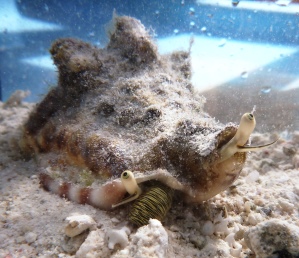Anatomy & Physiology
The two most species-rich of the traditionally defined strombid genera are Lambis and
Strombus and both possess similar soft tissue anatomies (Latiolais et al. 2006). One of the defining physiological characteristics of this group of organisms is that, like all gastropods, they undergo torsion. Torsion involves the 180 degree twist of the visceral mass during the larval stage of development. The result is that the mantle cavity and organs, which are posterior prior to torsion, become anterior after this counter clockwise rotation (Ruppert et al. 2004).
Most genera of Strombidae have a long, sharp (sometimes serrated), strong and somewhat sickle-shaped operculum (Kreipl & Poppe 1999). The operculum appears early in gastropod evolution at a similar time to torsion (Ruppert et al. 2004). Serves to fill the aperture, as a lever for moving forward and as a defensive weapon against predators like crabs and fish. Rarely does the operculum fill the whole aperture of the shell (Kreipl & Poppe 1999). And alsthough it may provide benefit to the adult for protection, it would not provide much benefit to the veliger larva which is generally eaten whole (Ruppert et al. 2004).
Strombid shells are made of calcium carbonate, with aragonite being the dominant polymorph. There are other polymorphs such as calcite and vaterite, but these are scarce or generally absent (De Torres et al. 2010). There are three layers that comprise the Strombidae shell structure (outer, middle and inner mineralized layers). These consist of first-, second- and third-order lamellae made of aragonite separated by organic matter within interfaces (De Torres et al. 2010).

Image displaying the eyestalks of Lentigo lentiginosus and the small antennae extending from each stalk. Note the right eyestalk emerging through the "Stromboid notch" (Photographer: Asia Armstrong).
The eyes of most gastropods are just used to detect light, however in conches are probably capable of forming an image to detect predators (Ruppert et al. 2004). The eye peduncles of Strombidae are long and muscular, and the button-shaped eyes are large and usually adorned with circular rings of blue, orange, yellow or red colour around a black central area. In most species, the right eyestalk is somewhat shorter than the left and this is possibly related to the presence of the “stromboid notch” (Kreipl & Poppe 1999). Recent strombids keep a careful watch on the surrounding environment with eyes located at the end of long and highly mobile pedicles. Nearby movements or shadows passing over the eyes result in a quick contraction of the columellar muscle(Savazzi 1991). The small antennae are located halfway along the eye pedicles, and probably warn the mollusc against the eye pedicles being accidentally squeezed between the shell and the substrate during locomotion. Since the eyes face upwards, they are not primarily used for directing the movements of the molluscs. The irises are often brightly coloured, and may deter predators by mimicking the eyes of higher organisms (Savazzi 1991).
|